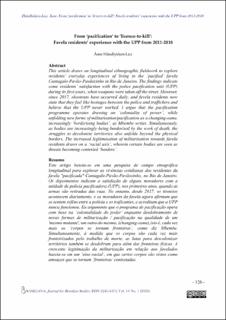| dc.contributor.author | Håndlykken-Luz, Åsne | |
| dc.date.accessioned | 2022-04-07T11:20:29Z | |
| dc.date.available | 2022-04-07T11:20:29Z | |
| dc.date.created | 2021-11-22T13:14:51Z | |
| dc.date.issued | 2021 | |
| dc.identifier.citation | Håndlykken-Luz, Å. (2021). From ‘pacification’ to ‘licence-to-kill’: Favela residents’ experience with the UPP from 2011-2018. Brasiliana: Journal for Brazilian Studies, 10(1), 126-153. | en_US |
| dc.identifier.issn | 2245-4373 | |
| dc.identifier.uri | https://hdl.handle.net/11250/2990508 | |
| dc.description.abstract | This article draws on longitudinal ethnographic fieldwork to explore residents’ everyday experiences of urban militarisation in a ‘pacified’ favela in Brazil. The findings indicate some residents’ satisfaction with the police pacification unit (UPP) during its first years, when weapons were taken off the street. However, since 2017, shootouts have occurred daily, and favela residents now state that they feel like hostages between the police and traffickers and believe that the UPP never worked. I argue that the pacification programme operates drawing on ‘coloniality of power’, while unfolding new forms of militarisation/pacification as a changing-same, increasingly ‘borderising bodies’, as Mbembe writes. Simultaneously, as bodies are increasingly being borderised by the work of death, the struggles to decolonise territories also unfold beyond the physical borders. The increased legitimisation of militarisation towards the urban poor draws on a ‘racial axis’, wherein certain bodies are seen as threats becoming contested ‘borders’. | en_US |
| dc.language.iso | eng | en_US |
| dc.rights | Attribution-NonCommercial-NoDerivatives 4.0 Internasjonal | * |
| dc.rights.uri | http://creativecommons.org/licenses/by-nc-nd/4.0/deed.no | * |
| dc.title | From ‘pacification’ to ‘licence-to-kill’: Favela residents’ experience with the UPP from 2011-2018 | en_US |
| dc.type | Journal article | en_US |
| dc.type | Peer reviewed | en_US |
| dc.description.version | publishedVersion | en_US |
| dc.subject.nsi | VDP::Annen kulturvitenskap: 069 | en_US |
| dc.subject.nsi | VDP::Other subjects within cultural studies: 069 | en_US |
| dc.subject.nsi | VDP::Annen kulturvitenskap: 069 | en_US |
| dc.subject.nsi | VDP::Other subjects within cultural studies: 069 | en_US |
| dc.subject.nsi | VDP::Annen kulturvitenskap: 069 | en_US |
| dc.subject.nsi | VDP::Other subjects within cultural studies: 069 | en_US |
| dc.subject.nsi | VDP::Annen kulturvitenskap: 069 | en_US |
| dc.subject.nsi | VDP::Other subjects within cultural studies: 069 | en_US |
| dc.source.pagenumber | 126-153 | en_US |
| dc.source.volume | 10 | en_US |
| dc.source.journal | Brasiliana: Journal for Brazilian Studies | en_US |
| dc.source.issue | 1 | en_US |
| dc.identifier.doi | https://doi.org/10.25160/bjbs.v10i1.126199 | |
| dc.identifier.cristin | 1957303 | |
| cristin.ispublished | true | |
| cristin.fulltext | original | |
| cristin.qualitycode | 1 | |

